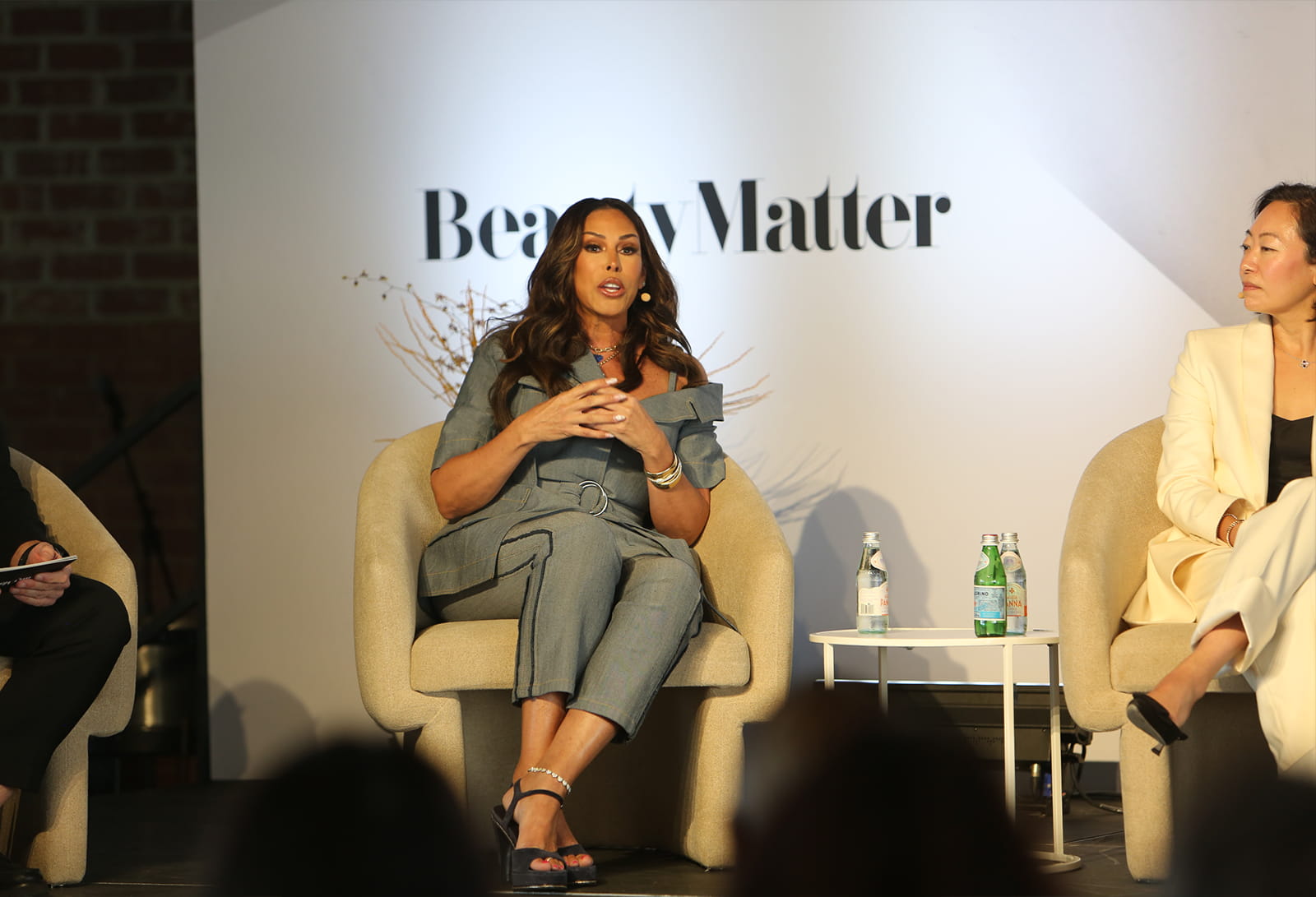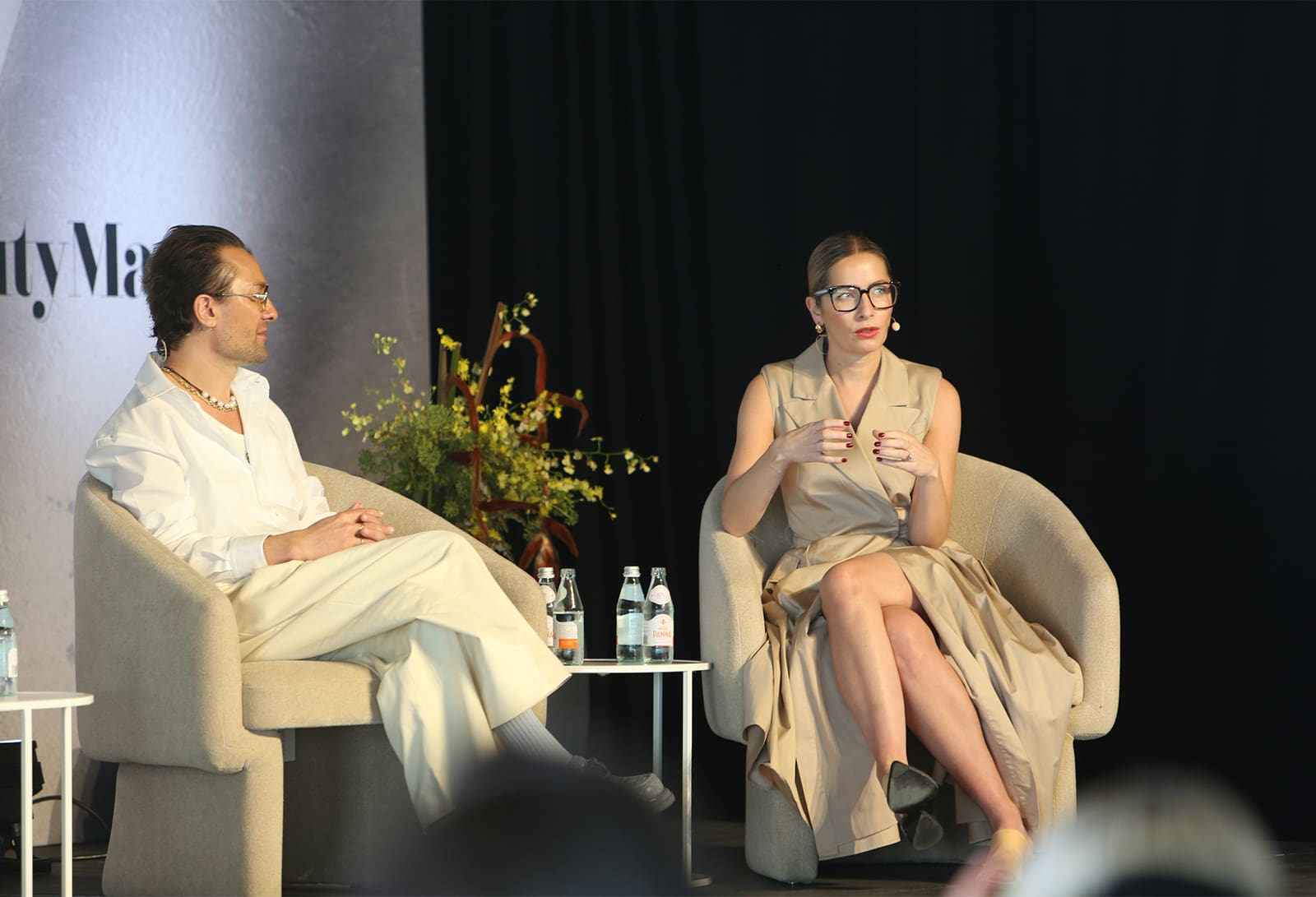There’s a three-digit landmark that captivates both the hearts of investors and founders: $100 million. It's an important turning point where one can either build and hold or plan a strategic exit. BeautyMatter co-founder and President John Cafarelli spoke to four founders who know this terrain firsthand: Marc Elrick, founder and CEO of Byoma; Ju Rhyu, co-founder of Hero Cosmetics; Colette Laxton, co-founder of The INKEY List; and Carolyn Aronson, founder and CEO of It's a 10 Haircare.
Cafarelli started the panel by asking each panelist what it took to reach the $100 million mark. Hero Cosmetics hydrocolloid patches helped the acne care brand hit the milestone four years into launching.
“We brought true innovation and something really different in a category that hadn't seen innovation in a really long time. In the very beginning, I always said, I want these acne patches to really be for anyone: it could be that 13-year-old adolescent or a woman in her 40s or 50s going through hormonal changes. We had a very wide demographic that we were able to serve. We had an amazing team—because execution is so important—that helped us to scale very quickly. We basically built our business on Amazon and Target,” Rhyu explained.
Laxton highlights The INKEY List as a consumer-centric brand in an age of opaqueness in the industry at its time of launch in 2018. “Consumers were really frustrated and asking for more. They wanted to know more about their skin. They wanted to know more about the products that they were buying. We set out with a very simple, clear mission that has not changed in six years, which is we want to spread the beauty of knowledge to the world,” she remaks. “We want to help support people, give them the knowledge they need, then they can make the right decisions. It's stupidly simple, but it worked. From day one, consumers got it.” Within six months, The INKEY List did a global exclusive Sephora deal in 32 countries.
Elrick, whose brand Byoma launched in 2022, managed to scale at breakneck speed. “I believe everything starts with an insight. No matter how big or small. With Byoma, that insight was we felt like the consumer was really overwhelmed and as a direct result were overtreating, overusing, and overexfoliating their skin. That then led to our belief that the source of most skin issues starts and ends with a compromised skin barrier. That led to the creation of the brand,” he explained. “Our mission was to disrupt and democratize skincare, and help build a better beauty industry by empowering the consumer to make smart, informed choices. It's about innovation and education. The product is just a byproduct of your bigger purpose. When you find that true purpose, that's when you know that you're building something that is different, authentic, and something that the consumer wants and needs.”
It’s a 10 Haircare is a business 18 years in the making, which reached this pivotal revenue point without any outside equity, building a slow and steady case. “I have grown this brand very steadily from day one, funding itself throughout the years. I was a hairdresser first, so I learned what it took to stay up with trends. Fashion, technology—that's what we do for a living. We are the creators. When we learn to embrace uniqueness, creativity, and bringing something to market that's actually going to move with the trends in the market and help to create them, how do you continue that path? What I've learned over the last 18 years, honestly, it's going to fill a book,” Aronson stated.
The conversation shifted to retail and how the big five retailers (Sephora, Ulta Beauty, Target, Walmart, Amazon) provided a crucial stepping stone to creating a profitable brand. Rhyu noted that some DTC brands are able to hit the $100 million mark without them by using a creator or celebrity for marketing arbitrage, or an “operational trick” as she calls it. Aronson remarked that It’s a 10 began in the professional channel and only sold through hairdressers for the first decade of business, with minimal online presence due to the lack of technology or social media available at the time. As the industry started shifting, accelerated by Covid, she opened up her distribution channels to the consumer side of the business.
“It was a progression that needed to happen and needs to happen within the whole professional beauty industry, I believe. It skyrocketed us. We already were doing close to $100 million at that point anyway. But since I've taken the company over in 2017, we've more than doubled this company. It is a major part of what's happening in our world, and we have to be open to embrace it,” she explained.


Laxton emphasized the importance of the right retail allies, stating, “As a young brand, I believe in the power and the equity that a brand can give you. We were very strategic in launching exclusively with Sephora. I know that a retailer can eat you alive. It's finding the right way for you. Exclusivity was the right way in which we could take Sephora's equity, really help them to brand build and support us so we could then focus our energy and resource and investments elsewhere. DTC is a tough game and it's getting tougher. Who knows where TikTok shop's going to go? But for me, if you can work with the retailer, being with a major retailer is such a huge stepping stone to getting there,” she said.
Elrick agreed with the other panelists, but noted that Byoma’s approach was customer-first. “We never focus on getting to a number. What we focus on is really understanding who is our customer, where are they shopping, what do they want, what do they need, and where do we meet them? We have always proudly been a retail-first business. I've set up four brands that all launch retail first. I work with all five of these big retailers and they're all incredible,” he stated. “I'm so proud that they're really now making it easier for indie brands to launch there. They're developing programs and platforms to really help founders on every stage of their journey.”
The conversation then shifted to Laxton’s learnings from previous brand launches that didn’t go as planned. She explained that The INKEY List was actually her fifth brand, but hit the jackpot in 12 months. With a separate body brand venture, she noted a big moment with lifestyle retailers and lots of positive consumer feedback. “It was cute, it was cool. People loved it. Did they continue to buy it? There was definitely that longevity piece of being cute, cool, and fun. Getting that first acquisition in is getting people to stay. From The INKEY List, what we learned now, we've taken it to the extreme of substance over style. The power in an enduring brand is the loyalty. We've been incredibly lucky that we've built such an amazing community,” she adds. “Ultimately you can have the coolest product in the world, [but] unless it works, unless people want to come back to you time and again, it's just not going to work.” She also noted that consumer feedback is incredibly important to any brand. “Genuinely listen to your consumer. If something has not got the traction, don't push water uphill,” she said. Part of The INKEY List taking this feedback onboard included changing their packaging three times in the first 12 months.
Elrick, who is also the founder of three tanning brands—Tan-Luxe, Isle of Paradise, and Tanologist—spoke to the importance of consumer insight and innovation in shaping the future of beauty. “But it also comes back to people, and culture, and really being really clear on your mission and creating a company and a culture where you embrace failure. In my company, I actively empower people to fail because I think if you're learning from it, you're not failing. You're moving forward, you're moving faster. The reason we've built all of these brands is because we've built this company of beauty warriors. Beauty warriors that champion our mission of moving an industry forward, shaping it, and ultimately serving the customer,” he enthused. Social media is the ideal tool for connecting and building a deep personal relationship with that customer.
Speaking on the takeaways she gleaned from losing her first company in 2002, Aronson remarked, “What I learned from that was not to try to do everything yourself, actually build the team around you that's going to help support you, bring you to the market in a way that is going to be extremely efficient. I describe building a brand like building a house. When you're building a house, you go to Home Depot. You really want to engage with companies that help you bring products to market that actually have multiple services under one roof.” She noted trying to do too much too fast without the proper infrastructure and vendors in place caused a lot of issues.
Aronson, Laxton, and Elrick agreed that a supportive and loving network, one about winning together rather than seeing each other as competition, was crucial. The conversation ended with each founder giving advice for other entrepreneurs in the audience.
“The $100 million metric is, to me, it's just a vanity metric. Why do we talk about it and why is it important? Because it symbolizes scale. It symbolizes that you've gotten to a point where there's true product market fit and some buyer can then take you to be a big, much bigger business. But build a brand for the long term. You should build a brand for generations,” Rhyu said. Elrick encouraged others to “stay in the game. It's really difficult. Most days are super painful. Stay true to who you are.” Laxton recommended “keeping an open mind and be prepared to embrace change. You have to be able to pivot on a drop of a hat and move with your company as it grows.”
Key Takeaways